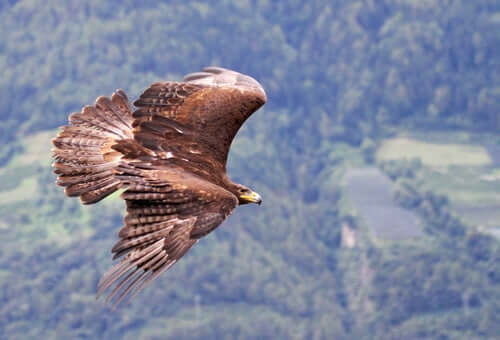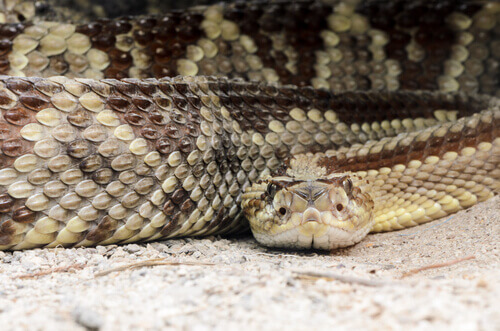The Great Biodiversity of Mexico's Fauna

This North American country, with some 386,100 square miles of territory, is home to thousands of species of animals and plants. In fact, it’s among the 12 most diverse nations in the world. If you want to get to know about some of the creatures that make up Mexico’s fauna, keep reading this article.
How is the fauna of Mexico?
With more than 700 known reptile species, nearly 450 mammal species, and almost 300 amphibian species, Mexico’s fauna is truly impressive. Some of its most famous animals are:
1. Monarch butterfly
This insect – which appears in this article’s cover photo – makes one of the most beautiful migratory journeys in the world (almost 3000 miles long) and one of its ‘stops’ is in Mexico, where there are even several sanctuaries that allow us to observe thousands of specimens at the same time. It’s very resistant to winter and can live up to nine months in this area.
The monarch butterfly can reach up to 4 inches long and has very striking orange wings with black lines and white markings. To differentiate between males and females, you only have to look at those dark ‘stripes’ – the males’ are thinner.
2. Golden Eagle
The golden eagle isn’t endemic to this nation, but it’s important on an ecological and cultural level. Like other birds of prey, the males are smaller than the females (they can reach 12 pounds and a wingspan of 6.5 feet). However, they both have the same plumage: dark brown with gold on the neck and head, and white on the shoulders and end of the tail.

These birds are monogamous, hunt from the air, and feed on mice, hares, rabbits, snakes (as you can see on the Mexican flag), and even larger animals such as foxes and goats.
3. Mexican gray wolf
This wolf subspecies is another important part of Mexico’s fauna and is the smallest of the Canis lupus family. It’s 31 inches tall and 53 inches long, and can weigh a maximum of around 100 pounds. From a distance, it can look like a medium-sized dog.

4. Gray whale
This is one of the largest mammals in the world and makes a long migration from Mexico, where it gives birth in winter, to the Bering Sea, where it feeds during the summer. During its stay on the Mexican coast, it really is a wonderful natural spectacle to witness.

5. Crotalus durissus
This poisonous reptile is another of the animals that make up Mexico’s fauna. It measures about 7 inches, with a scaly body that has protuberances that make it even more dangerous.

Once the venom is injected, it can cause progressive paralysis of the body, breathing problems, and even blindness. Even so, it was highly revered by the Mayans, and can be seen carved in various temples.
This North American country, with some 386,100 square miles of territory, is home to thousands of species of animals and plants. In fact, it’s among the 12 most diverse nations in the world. If you want to get to know about some of the creatures that make up Mexico’s fauna, keep reading this article.
How is the fauna of Mexico?
With more than 700 known reptile species, nearly 450 mammal species, and almost 300 amphibian species, Mexico’s fauna is truly impressive. Some of its most famous animals are:
1. Monarch butterfly
This insect – which appears in this article’s cover photo – makes one of the most beautiful migratory journeys in the world (almost 3000 miles long) and one of its ‘stops’ is in Mexico, where there are even several sanctuaries that allow us to observe thousands of specimens at the same time. It’s very resistant to winter and can live up to nine months in this area.
The monarch butterfly can reach up to 4 inches long and has very striking orange wings with black lines and white markings. To differentiate between males and females, you only have to look at those dark ‘stripes’ – the males’ are thinner.
2. Golden Eagle
The golden eagle isn’t endemic to this nation, but it’s important on an ecological and cultural level. Like other birds of prey, the males are smaller than the females (they can reach 12 pounds and a wingspan of 6.5 feet). However, they both have the same plumage: dark brown with gold on the neck and head, and white on the shoulders and end of the tail.

These birds are monogamous, hunt from the air, and feed on mice, hares, rabbits, snakes (as you can see on the Mexican flag), and even larger animals such as foxes and goats.
3. Mexican gray wolf
This wolf subspecies is another important part of Mexico’s fauna and is the smallest of the Canis lupus family. It’s 31 inches tall and 53 inches long, and can weigh a maximum of around 100 pounds. From a distance, it can look like a medium-sized dog.

4. Gray whale
This is one of the largest mammals in the world and makes a long migration from Mexico, where it gives birth in winter, to the Bering Sea, where it feeds during the summer. During its stay on the Mexican coast, it really is a wonderful natural spectacle to witness.

5. Crotalus durissus
This poisonous reptile is another of the animals that make up Mexico’s fauna. It measures about 7 inches, with a scaly body that has protuberances that make it even more dangerous.

Once the venom is injected, it can cause progressive paralysis of the body, breathing problems, and even blindness. Even so, it was highly revered by the Mayans, and can be seen carved in various temples.
All cited sources were thoroughly reviewed by our team to ensure their quality, reliability, currency, and validity. The bibliography of this article was considered reliable and of academic or scientific accuracy.
- Hammerson. G. & Cannings, S. (12 de enero del 2023). Canis lupus baileyi: mexican wolf. Nature Serve Explorer. Consultado el 20 de diciembre del 2023. https://explorer.natureserve.org/Taxon/ELEMENT_GLOBAL.2.104666/Canis_lupus_baileyi
- Hammerson, G. (12 de enero del 2023). Aquila chrysaetos, Golden Eagle. Consultado el 20 de diciembre del 2023. https://explorer.natureserve.org/Taxon/ELEMENT_GLOBAL.2.100925/Aquila_chrysaetos
- IUCN SSC Amphibian Specialist Group. (2020). Ambystoma mexicanum. The IUCN Red List of Threatened Species. Consultado el 21 de diciembre del 2023 https://www.iucnredlist.org/species/1095/53947343
- Marceau, J. (2001). Nasua narica: white-nosed coati. Animal Diversity Web. Consultado el 21 de diciembre del 2023 https://animaldiversity.org/accounts/Nasua_narica/
- Nash, H. (22 de septiembre del 2022). The 201 Most (& Least) Biodiverse Countries. The Swiftest. Consultado el 21 de diciembre del 2023. https://theswiftest.com/biodiversity-index/
- Nigenda, S., Gompper, M., Valenzuela, D., Lay, A., Kapheim, K., Hass, C., Booth-Binczik, S., Binczik, G., Hirsch, B., McColgin, M., Koprowski, J., McFadden, K., Wayne, R., & Koepfli, K. P. (2019). Phylogeographic and diversification patterns of the white-nosed coati (Nasua narica): Evidence for south-to-north colonization of North America. Molecular phylogenetics and evolution, 131, 149-163. https://www.sciencedirect.com/science/article/abs/pii/S1055790317308114
- Pérez-Irineo, G., & Santos-Moreno, A. (2014). Density, distribution, and activity of the ocelot Leopardus pardalis (Carnivora: Felidae) in Southeast Mexican rainforests. Revista de biologia tropical, 62(4), 1421-1432. https://www.scielo.sa.cr/scielo.php?pid=S0034-77442014000400013&script=sci_arttext
- Petruzzello, M. (diciembre 7 de 2023). Monarch Butterfly. Britannica Encyclopedia. Consultado el 21 de diciembre del 2023 https://www.britannica.com/animal/monarch-butterfly
- Secretaría de Medio Ambiente y Recursos Naturales (10 de junio de 2021). Seis flores endémicas que son un regalo de México para el mundo. Gobierno de México. Consultado el 6 de enero del 2024. https://www.gob.mx/semarnat/articulos/seis-flores-endemicas-que-son-un-regalo-de-mexico-para-el-mundo?idiom=es
- Torres, E. (2023). Cascabel pigmea mexicana: Crotalus ravus. EncicloVida. Consultado el 21 de diciembre del 2023 https://enciclovida.mx/especies/27360-crotalus-ravus
- Wheatley, H., & Hermes, C. (2023) Species factsheet: Euptilotis neoxenus. Consultado el 21 de diciembre del 2023 https://datazone.birdlife.org/species/factsheet/eared-quetzal-euptilotis-neoxenus/text
This text is provided for informational purposes only and does not replace consultation with a professional. If in doubt, consult your specialist.








